Science : Term 2 Unit 3 : Changes Around Us
Evaluation
I. Choose the best answer
1. When a woollen yarn is knitted to get a sweater, the change can be classified as _______ .
a. physical change
b. chemical change
c. endothermic change
d. exothermic change
Answer: 1. Answer: a. physical change
2. ___________ of the following are endothermic changes.
a. Condensation and melting
b. Condensation and freezing
c. Evaporation and melting
d. Evaporation and freezing
Answer: c. Evaporation and melting
3. The chemical change is ____________ .
a. water to clouds
b. growth of a tree
c. cow dung to bio-gas.
d. ice-cream to molten ice-cream.
Answer: c. cow dung to bio-gas
4. ________is an example of a periodic change.
a. Earthquake.
b. Formation of rainbow in sky
c. Occurrence of tides in seas.
d. Showering of rain
Answer: c. Occurrence of tides in seas.
5. _________ is not a chemical change.
a. Dissolution of ammonia in water
b. Dissolution of carbon-di-oxide in water
c. Dissolution of oxygen in water
d. Melting of polar ice caps
Answer: d. Melting of polar ice caps
II. Fill in the blanks
1. Filling up a balloon with hot air is a physical change.
2. Stretching gold coin into a ring is a physical change.
3. Opening a gas cylinder knob converts liquid fuel into gas fuel. This is an example of physical change.
4. Spoiling of food is a chemical change.
5. Respiration is a periodic change.
III. True or False. If false, give the correct answer.
1.Cutting of cloth is an example of a periodic change. [False]
Cutting of cloth is an example of a physical change.
2. Taking a glass of water and freezing it by placing it in the freezer is a chemical change. [False]
Taking a glass of water and freezing it by placing it in the freezer is a physical change.
3. A bean plant collecting sunlight and turning it into bean seeds is an example of physical and non-periodic change. [False]
A bean plant collecting sunlight and turning it into bean seeds is an example of chemical and periodic change.
4. If the chemical properties of a substance remain unchanged and the appearance or shape of a substance changes it is called a periodic change. [False]
If the chemical properties of a substance remain unchanged and the appearance or shape of a substance changes it is called a physical change.
5. Tarnishing of silver is an example of endothermic change. [False]
Tarnishing of silver is an example of chemical change.
IV. Match the following
A B C
1. Melting : Change of state from liquid to solid – Ticking of clock
2. Condensation : Change of state from liquid to gas – Formation of ice cube
3. Evaporation : Change of state from solid to liquid – Collecting flowers
4. Freezing : Change of state from gas to liquid – Ice cube to water
5. Periodic change : Occurs at irregular time intervals – Water to steam
6. Non-periodic change : Occurs at regular time intervals – Steam to water drops

Answer
1. Melting : Change of state from solid to liquid – Ice cube to water
2. Condensation : Change of state from gas to liquid – Steam to water drops
3. Evaporation : Change of state from liquid to gas – Water to steam
4. Freezing : Change of state from liquid to solid – Formation of ice cube
5. Periodic change : Occurs at regular time intervals – Ticking of clock
6. Non-periodic change : Occurs at irregular time intervals – Collecting flowers
V. Classify the following changes as physical and chemical changes
A rough piece of wood is sanded and polished resulting in change in texture, Rusting of a iron nail, Painting the grill, Bending a paper clip, Pounding silver into thin plate, Rolling the chappathi dough into thin wire, Occurrence of day and night, eruption of volcano, burning of matchstick, dosa from the batter, blinking of eyelids, occurrence of a thunderstorm, rotation of the earth, formation of eclipses.
Physical changes
1. A rough piece of wood is sanded and polished resulting in change in texture
2. Painting the grill
3. Bending a paper clip
4. Pounding silver into thin plate
5. Rolling the chappathi dough into thin layer
6. Blinking of eyelids
Chemical changes
1. Rusting of an iron nail
2. burning of matchstick
3. dosa from the batter
Periodic change
1. Occurrence of day and night
2. Rotation of the earth
3. Formation of eclipses.
Non-periodic change
1. eruption of volcano
2. occurrence of a thunderstorm
VI. Analogy
1. Physical Change: Boiling::Chemical Change: Rusting of iron.
2. Wood to saw dust: Physical change :: Wood to Ash: Chemical change
3. Forest fire: Non-periodic change change::Change in period in a school: periodic change
VII. Very short answer type question
1. State two examples of periodic changes.
(i) Rotation and Revolution of the earth
(ii) Beating of the heart
2. Mention any two exothermic reactions.
(i) Water freezes into ice by giving out heat.
(iii) Steam condenses into water by giving out heat.
3. Cold milk is heated and it becomes hot. Which type of change it is?
Cold milk when heated becomes hot. It is a physical change.
4. What type of change is artificial ripening of fruit?
Artificial ripening of fruit involves the use of chemicals. It is a chemical change.
5. What type of change is colouring of a paper?
Colouring of paper is a physical change.
6. Growing of nails is a periodic change. Why?
Nails keep growing little by little every day. The growth is repeated as long as one is alive. So the growing of nails is a periodic change.
7. What type of energy changes is associated when ice melts?
Ice absorbs heat and becomes water. It is an endothermic energy change. Melting of ice involves change in state. Solid state is changed into liquid state. It is a physical change.
VIII. Short answer type question
1. Distinguish physical and chemical changes.
Physical changes are the changes in which only physical properties of a substance undergo a change and there is no change in its chemical composition.
Changes that occur with the formation of new substance with different chemical composition are called chemical changes. They are associated with the evolution or absorption of heat or light energy.
2. How can a change occur in a substance?
A change may occur in colour, state and texture of a substance. Physical properties such as lustre, malleability and ductility, density, viscosity, solubility, mass, volume undergo some change.
3. Can you suggest a method to collect water from sea water?
Sea water can be boiled and the steam that comes out must be cooled. When steam condenses it becomes water. This water is pure and it is free from salts. This process is known as distillation.
4. Is solar eclipse a periodic change? Give your reason.
The earth and the moon revolve round the sun. When the moon comes in between the sun and the earth, the earth is engulfed in the shadow of the moon. This is called solar eclipse. It occurs at regular intervals. So it is called a periodic change.
5. What is the difference between dissolution of sugar and burning of sugar?
(i) Dissolution of sugar is a physical change. The sugar dissolved in water sets deposited under the water after some time. This is only a temporary change.
(ii) When sugar is burnt it undergoes chemical change and only black carbon remains as residue. We cannot get back sugar from it. So it is called a chemical change.
IX. Long answer type question
1. Explain the following statement: Digestion is a chemical change.
Digestion is a chemical change. The food we eat is chewed in the mouth. The enzymes in the saliva bring about some changes in the food. Then it goes to the stomach. It is broken down into smaller and smaller components. A number of enzymes play important roles in digesting carbohydrates, proteins and lipids. The smaller substances are absorbed by small intestines. Then they join the blood stream. Thus during digestion, many changes take place in the food we eat. From the enzymes in saliva to the enzymes in the stomach many enzymes act on the food and bring about chemical changes. These changes are permanent and irreversible. So digestion is called a chemical change.
2. How the iron blade is fixed into a wooden handle in tools used to dig the soil?
It is not easy to fix a wooden handle into hole in the iron blade. To fix it, they heat the hole of the iron blade. When it is heated sufficiently the hole in the iron blade expands. Now one end of the wooden handle is inserted into the hole easily. Then cool water is sprayed on the iron blade. On cooling the hole contracts and it grips the wooden handle tightly. This kind of heating and cooling brings about a physical change.
X. Higher order Thinking questions
1. Peeled and unpeeled banana does not look the same. Does that mean peeling banana is a chemical change?
A peeled banana is exposed to air. It reacts with the gases in the air and changes colour. So the peeled banana undergoes a chemical change. As the unpeeled banana is protected by a skin it doesn’t undergo any change.
2. A very hot glass on putting in cold water cracks. What does this change indicate?
A hot glass is in an expanded state. When cold water is put in it the hot glass shrinks suddenly. As a result it cracks. This is a physical change brought about by heat and coldness. The glass may crack but it does not undergo any chemical change.
3. Boiling of water is a physical change; but boiling of egg is a chemical change. Why?
The boiled water becomes steam. When the steam is cooled, we get water once again. This is a change of state and it is a physical change.
But when egg is boiled, the contents of the egg undergo permanent, irreversible chemical changes. We cannot bring the egg to its former position. So it is called a chemical change.
XI. Assertion – Reason type question
1. Assertion: The explosion of fire cracker is a physical change.
Reason: A physical change is a reversible change
a. Both A and R are true and R is the correct explanation of A.
b. Both A and R are true but R is not the correct explanation of A.
c. A is true but R is false.
d. A is false but R is true.
Answer : d. A is false but R is true.
2. Assertion: The process of conversion of liquid water to its vapours by heating the liquid is called boiling.
Reason: The process of conversion of water vapours to liquid by cooling the vapours is called condensation.
a. Both A and R are true and R is the correct explanation of A.
b. Both A and R are true but R is not the correct explanation of A.
c. A is true but R is false
d. A is false but R is true.
Answer : b. Both A and R are true and R is not the correct explanation of A.
3. Assertion: Burning of wood log to charcoal is a physical change.
Reason: The products formed of burning a piece of wood can be easily converted back to wood log.
a. Both A and R are true and R is the correct explanation of A.
b. Both A and R are true but R is not the correct explanation of A
c. A is true but R is false
d. A is false but R is true.
Answer : Note i) Burning of wood into charcoal is a chemical change.
ii) The charcoal cannot be converted into a wooden log. So both Assertion and Reason are false.
4. Assertion: The formation of iron oxide from iron is a chemical change.
Reason: For the rust to form from iron, it must be exposed to air and water.
a. Both A and R are true and R is the correct explanation of A.
b. Both A and R are true but R is not the correct explanation ofA.
c. A is true but R is false.
d. A is false but R is true.
Answer : a. Both A and R are true and R is the correct explanation of A.
5. Assertion: A drop of petrol when touched with finger gives a chill feeling. Reason: The above phenomenon is an endothermic one.
a. Both A and R are true and R is the correct explanation of A.
b. Both A and R are true but R is not the correct explanation of A.
c. A is true but R is false.
d. A is false but R is true.
Answer : a. Both A and R are true and R is the correct explanation of A.
XII. Picture based question
1. Observe the picture and list down the changes that are accompanied in the picture.
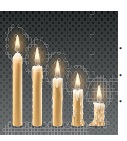
a) Solid wax becomes liquid.
b) The liquid turns into gas and bums.
c) The molten liquid wax condenses into solid wax at the bottom
2. Observe the picture containing a kettle and note that it has salt water in it and answer the following questions:
a. What is name of the process that is done to the kettle?
Boiling
b. What will happen to the content of the kettle?
Water in the kettle becomes steam.

c. What kind of change is occurring on the cold surface of the metal plate?
A physical change called condensation.
d. What can you say about the quality of water that is obtained in the beaker?
The water obtained in the beaker is pure. It is free from all kinds of salts.
Student Activities
Look at the following list. Identify the physical and chemical changes and fill in the given table.
(rusting of iron, digestion of food, boiling egg, rotting banana, mixing sand and water, chopping wood, crushing a can, mixtures of different coloured buttons, burning of wood)
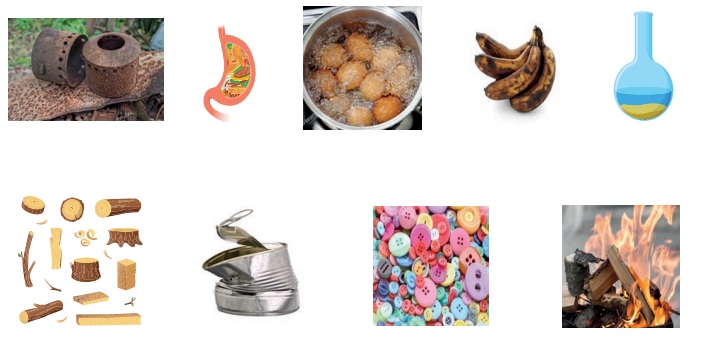

ACTIVITY 1
Melting of ice and freezing of water
Though ice and water look different, they are both made of water molecules. This means that no new substance is formed during the melting of ice, only a change of state from solid to liquid takes place during the melting of ice. So, the melting of ice to form water is a physical change.

The change which occurs during the melting of ice to form water can be reversed easily by freezing the water to form ice again by keeping a beaker of water in the freezer zone of a refrigerator.
ACTIVITY
Activity 2
You must be remembering an activity done in Class six, in which we have taken two same shaped glasses and fill them with equal amount of water from same tap. We kept one under the hot sun and other under the shadow. After three to four hours, we saw that there is difference in water levels. The one kept in the hot place witness more evaporation compared to the one in shade. From this we can conclude that higher the temperature, the rate of evaporation will be more. As the temperature increases, more molecules are able to break free from the surface. Thus the rate of evaporation increases with rising temperature.
Activity 3
Take two pans, one wide and another narrow. Fill hot water in both to the same depth. Keep them in open. Observe after one to two hours. The pan that is wide has cooled more than the narrow one. That is more the surface area; the rate of evaporation is more.
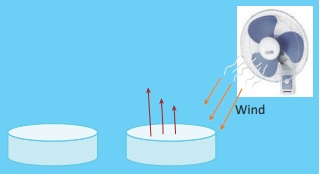
From this, can you guess why we unfurl the clothes while putting them to dry, rather than just drape them over the cloth line?
Greater the surface of conversion of a liquid, more molecules are available for evaporation.
Wet clothes dry faster when we unfurl (Spread) them because the rate of evaporation depends on the surface area. If the surface area will be more, rate of evaporation will be higher or more.
Activity 4
Take sugar solution in a shallow, broad bowl. Place the bowl in hot sun for a few hours. See that the bowl does not get any disturbance for the whole day. You can see that the solvent in the sugar solution evaporates leaving the sugar crystals in the bowl.
ACTIVITY 5
Sublimation
Take some camphor in a porcelain dish and cover it with a clean glass funnel. Close the mouth of the funnel with small amount of cotton wool. Heat the contents in the dish. can you see that camphor changes into vapour state without becoming liquid.
Ammonium chloride is another substance that undergoes sublimation.
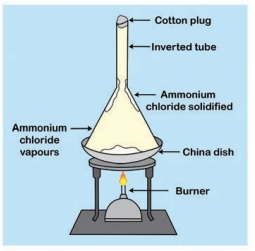
ACTIVITY 6
Crystallizing copper sulphate
Take about 100ml of water in a beaker. Heat the water over a burner till it boils. Add impure copper sulphate to the hot water with constant stirring. Continue to add copper sulphate till the solution takes up the added copper sulphate, that is, the added copper sulphate will not dissolve anymore. Filter the contents on a glass plate and allow it to cool. You could see crystals of copper sulphate in a few hours.
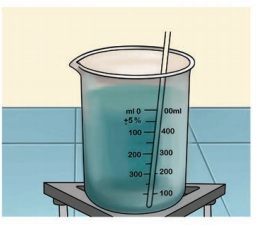
When food gets spoiled, it produces a foul smell. Shall we call this change as a chemical change?
Yes, it is a chemical change.
Discuss in the class. Give your reflections.
Try yourself
Cut a fresh slice of potato and brinjal and keep it away for sometime.
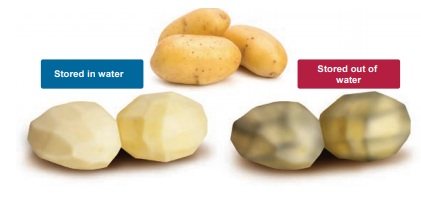
Discuss and give your answer
You know that plant produce their food by a process called photosynthesis.
Can we call photosynthesis a chemical change? Yes
The Iron Pillar at Delhi
Amazingly there is an iron that did not rust! There is an iron pillar at the Qutub complex in Delhi which is more than 1600 years age. Even after such a long period, the iron pillar kept in open spaces has not rusted at all. This shows that Indian scientists made great advances in metal making technology even at 16th century which enabled them to make this iron pillar having the quality of great rust resistance.
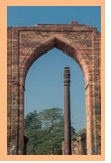
Another way of preventing rusting is to deposit a layer of a metal like chromium or zinc on iron. This is called galvanization and you will learn about this detail in higher classes.

ACTIVITY 7
Take a small piece of magnesium ribbon and clean it by rubbing its surface with a sand paper. Hold the magnesium ribbon at one end with a pair of tongs and bring its other end over the flame of a burner.

Magnesium ribbon must be cleaned before burning. So that the layer of magnesium oxide can be removed in order to get the desired chemical reaction.
Magnesium ribbon burns in air with a dazzling flame and forms a white ash, I magnesium gets oxidised to magnesium oxide.
ACTIVITY 8
When baking soda and lemon juice are mixed together, then bubbles of carbon-di-oxide are formed along with the formation of some salt and water. Take 10 ml of lemon juice and add pinch by pinch of baking soda to it. Actually when we mix baking soda with lemon juice, we will hear a hissing sound when bubbles of carbon-di-oxide coming out and rising in the reaction vessel.
ACTIVITY 9
Ask a student to stretch both hands, put a pinch of soap powder in one hand and a pinch of glucose in the other hand. Add a few drops of water to soap powder and ask how the student feels upon adding water. Now add a few drops of water to the glucose at the other hand. Now ask the student how he /she feels on adding water, What is the feeling when water is added to glucose?
We feel cool.
What is the difference when water is added to soap powder and when water is added to glucose?
When water is added to soap powder we feel hot. When water is added to glucose we feel cold.
Every year we observe that seasons changes. We go from rains to winter and winter to summer and so on.
* What types of clothes are worn in winter? Beanie, Sweater, Gloves, Fleece jacket, Jeans, Mittens, Scarf, Socks
* What are the clothes that we wear in summer? Cotton dress














